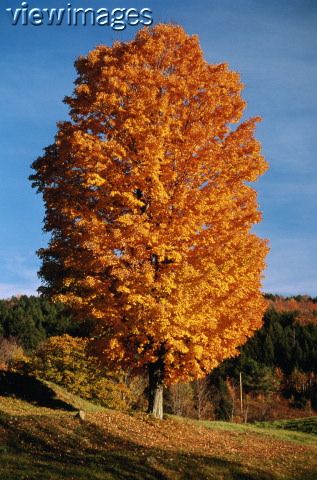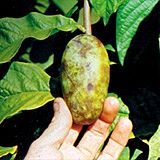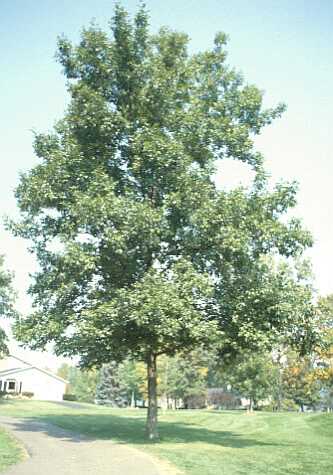
Genus
: AcerSpecies: saccharum 
Family: Aceraceae (maple)
Common Name: sugar maple
Leaf: opposite, simple, three-five lobed, acuminate, cordate, slightly coarse toothed
Bud: terminal usually 3, hard brown, pointy, imbricate, usually <¼ inch long. More woody than red & silver maple buds
Twig: brown, angled tiny lenticels.
Bark: smooth gray-brown when young, but significantly rougher than Acer rubrum when young, becomes deeply furrowed and browner with age.
Fruit: samara, horseshoe-shaped, nearly parallel wings. 1-2". AUTUMN.
Flower: - -
Habit: more open grown trees are characteristically oval, getting rounder with age. Branches curve slightly up, then out perpendicular then steeply back up again forming oval.
Fall Color: yellow, apricot, orange, red. Very ornamental. Farther north, more red color because of hot days / cold nights. Primary fall color tree in New England.
Eco/Notes: used for maple syrup. Not generally tolerant of human activity. Not a good tree for high traffic areas in parks (soil compaction). Often lumped in "cline" (from Thurs. class) with black maple Acer nigrum, called Acer saccharum-nigrum.
Key ID Feature(s): opposite branching, buds.

Genus:
Asimina (native American name)Species: triloba
Family: Annonaceae (custard apple)
Common Name: pawpaw
Leaf: alternate, simple, 6-12" long, ½ as wide. Obovate-oblong acuminate, tapered base, entire, glabrous above, pubescent on veins below.
Bud: vegetative are naked, terminal, 1/3 to ½ -inch long, pubescent, brown. Flower buds are globose, rounded 2-3 scales.
Twig: brown
Bark: brown with gray areas when young, rough and slightly scaly mature.
Fruit: Very large bloomy berry, 2-5", greenish-yellow, turning black. Highly edible, tastes like a banana-pear-mango, with richer custardy texture. Fall. Tree usually must get some sun for significant amount of fruit to form. Excellent wildlife food. Raccoons love pawpaws, animals eat most of them before people can find them. Fruit must be ripe (yellow to brown color like a banana means ripe) or it tastes very bad. Animals usually eat day before it is ripe.
Flower: dark purple red, tulip-like, 1-2" across. (picture on Virginia Tech dendrology tree page) in May.
Habit: more open grown is very dense, pyramidal, and tropical-looking. In shade can be straggly with long stems and intermittent branches. Tend to form in loose colonies.
Fall Color: yellow-green
Eco/Notes: mesic woods, ravine slopes. Very healthy fruit, highly nutritious, unsaturated fats, balanced amino acids. Has been considered for commercialization. Northernmost plant in family, most Annonaceae are tropical. For more info on fruit see: http://www.crfg.org/pubs/ff/pawpaw.html. If you want to attend the Ohio Paw Paw festival see: http://www.integrationacres.com/.
Key ID Feature(s): buds, stem, location, colonies. Often found with other plants in this ecosystem (see list).
Genus: Carpinus
Species: caroliniana
Family: Betulaceae (birch)
Common Name: American hornbeam, also called blue beech, ironwood, musclewood, and water beech, but is NOT in beech family or genus.
Leaf: alt. Simple, 2-5" loing 1-2" wide, ovate acuminate, sharply double serrate. Fairly straight parallel elm-pinnate veins, pubescent on veins beneath. Contrast with Beech, these two are often confused on quiz.
Bud: imbricate, small, 1/6 to ¼-inch long. Reddish brown -black. Usually pubescent. Contrast with Beech.
Twig: dark red-brown, angled, shining, smooth, sometimes hairy. lenticels
Bark: dark bluish-gray. muscle-like, sinewy branches and bole.
Fruit: seed-like nutlet enclosed in 3-lobed leafy bract but does not resemble the main leaves at all.
Flower: spring
Habit: small-medium. Can be single stemmed or multi. Wide-spreading flat-round top. 20-30' but can get quite high (50') under good conditions
Fall Color: yellow, orange, red
Eco/Notes: Primarily an understory plant, tolerates deep shade, but will grow in sun. Often confused with beech but note buds are very different. Often killed by hornbeam borer.
Key ID Feature(s): muscle-like stem, bark, buds.

Genus:
CaryaSpecies: cordiformis
Family: Juglandaceae (walnut)
Common Name: Bitternut hickory
Leaf: pinnately compound, usually 7 leaflets (5-9). Leaflets sharply serrate, ovate to lanceolate, glabrous above, pubescent below. Pubescent rachis.
Bud: Sulphur yellow. Valvate scales, almost looks naked, pubescent. Easily distinguished from other hickories.
Twig: greensh-gray or reddish-gray,
Bark: Gray-brown. Smooth when young, becoming shallowly furrowed with interlacing ridges when old. Unlike shagbark. Thin, tight and hard to touch.
Fruit: Fall. Pecan-like. Dusty yellow-green, turns dark brown after it falls. About 1-1.5". Smaller than other hickories we will study. Only tip will split, rest of outer husk is solid. Bitter.
Flower: - -
Habit: 50-75' tends to have mildly vase-shaped habit with open rounded top.
Fall Color: yellow-brown.
Eco/Notes: Slow growing, but highly urban tolerant. Seems to tolerate human activity well, especially once established. Good tree to leave for shade if you're clearing an area for human use. Note, tree is not typically riparian, it is mesic but will grow from bottomland up to ridges. Member of the Pecan group. Climax tree. See if you can find Carya cordiformis growing in the courtyard of the North Dorms on campus (several trees there). Most common hickory in our area.
Key ID Feature(s): yellow bud, bark, mesic site.
Genus:
Catalpa (Cherokee name for plant)Species: spp.
Family: Bignoniaceae (Trumpet creeper or Catalpa family)
Common Name: Catalpa, Cigar tree.
Leaf: Whorled. 3 at node. Simple, large, 6-12", broad-ovate to deltoid. Cordate to truncate base, acuminate. Densely pubescent beneath.
Bud: whorled, no terminal. Small hemispherical, above leaf scar. Much smaller than leaf scar.
Twig: stout, downy reddish green to yellow
Bark: Thick. Grayish brown, can be ridged and furrowed, or, scaly.
Fruit: long yellowish-green cigar thingy with samara-like seeds inside.
Flower: big flowers, sort-of conical corolla, white, spring.
Habit: coarse.
Fall Color: green, or slightly yellow.
Eco/Notes: grows in variety of environments, prefers mesic. Tolerates tough conditions. C. speciosa is northern, C. bignonioides is southern. Intermediate successional species.
Key ID Feature(s): whorled leaf scars and bud.
Genus:
CornusSpecies: alternifolia
Family: Cornaceae (dogwood family)
Common Name: Alternate-leaved dogwood. Pagoda dogwood.
Leaf: dogwood leaf, except alternate. Crowded near end of twigs, may appear opposite or whorled but are not. Check along stem. Only alternate dogwood. Unusual since leaf arrangement is usually by family.
Bud: terminal buds small (1/4 inch long), ovoid with two or three scales. Reddish. Flower buds pointy.
Twig: variable but can be purple-brown. Smooth shiny.
Bark: tan to brown, patterned, but NOT raised-blocky like flowering dogwood.
Fruit: blue-black with reddish stalks.
Flower: white, flat-topped cluster. NO showy white bracts like flowering dogwood. Not especially exciting.
Habit: sort of horizontal flat-topped, low-branched tree. Sympodial, similar to flowering, but different.
Fall Color: slight reddish purple. More sun = more color.
Eco/Notes: Understory, forest-edge. Indicator of fertile mesic conditions (good site). Unusual exception to family rule for bud arrangement. Only Cornus that is alternate.
Key ID Feature(s): bark, buds.
Genus:
EuonymousSpecies: obovatus
Family: Celastraceae (Staff Tree or Bittersweet Family)
Common Name: running strawberry bush
Leaf: opposite, obovate, toothed.
Bud: very light green
Twig: green, usually about 5-6" long, but can get to over 1 foot.
Bark: - -
Fruit: orange red to crimson, waxy-looking, usually 3-lobed, warty capsules approximately 0.75 inches across
Habit: generally a prostrate ground cover with a long runner and a series of branches.
Fall Color: None
Eco/Notes: Indicates mesic site, relatively undisturbed site.
Key ID Feature(s): habit, leaves
Genus:
FagusSpecies: grandifolia
Family: Fagaceae (beech)
Common Name: American beech
Leaf: alternate simple ovate-oblong straight, parallel elm-pinnate veins. Pubescent midrib, vein axils. Singly serrate.
Bud: long thin point "cigar bud" imbricate, up to 1". Sharp point. Strongly angled. Look almost like thorns.
Twig: slender, slightly zig-zag, smooth, shining silver-gray.
Bark: thin, smooth, gray, initials.
Fruit: beech nut. Three-winged nut in prickly involucre. Edible.
Flower: - -
Habit: open grown has large crown, low-branched. Fairly perpendicular branches. Can have large surface roots.
Fall Color: golden-bronze
Eco/Notes: Climax canopy tree.
Key ID Feature(s): buds, stem, bark
Genus:
FraxinusSpecies: americana
Family: Oleaceae (olive)
Common Name: White Ash
Leaf: pinnately compound, usually 5-9 leaflets. Terminal leaflet usually smaller. Leaf scar is flat-topped semi-circle.
Bud: pubescent, brown, hemispherical, terminal. 2-3 pairs of scales. Laterals above leaf scars.
Twig: stout, gray-green-olive, smooth.
Bark: gray-brown-tan, corky ridges form diamond pattern. Ridges can get scaly in older trees.
Fruit: single-winged samara. 1-2" long, ½-inch wide. Ash samaras are usually comprised of a single wing with seed at one end.
Flower: Spring. Can get a flower gall that leaves dead distorted flowers on the tree throughout the year (see tree west of Kottman) possible ID feature.
Habit: Large tree. 80'. pryamidal to oval, becoming rounder with age.
Fall Color: Purple (most of the time). Distinctive.
Eco/Notes: This tree is difficult to distinguish from green ash. Main differences are: white ash has sharper diamond pattern in mature bark, white ash has purple fall color, and leaf scar is different. Prefers mesic conditions, does not tolerate dry, but tolerates wide variety of soils. Pioneer invader, some trees persist into canopy.
Key ID Feature(s): terminal bud, leaf scars, bark, fall color (when available), coarse opposite branching.

Genus:
LinderaSpecies: benzoin
Family: Lauraceae (laurel family)
Common Name: Spice Bush.
Leaf: alternate simple, oblong-ovate, short acuminate tip, cuneate base. Ciliate margin. Pleasant fragrance (one student suggested "lemon pledge").
Bud: flower buds stalked globose, good ID feature.
Twig: new twigs are green, slender, smooth, also have fragrance
Bark: gray-brown with white lenticels.
Fruit: bright red drupe, September, more common in plants with sun.
Flower: small yellow, Spring.
Habit: rounded shrub. Loose and open in understory, dense and full in sun.
Fall Color: golden yellow.
Eco/Notes: understory, forest edge.
Key ID Feature(s): fragrance, flower buds.
Genus:
MenispermumSpecies: canadense
Family: Menispermaceae (moonseed family)
Common Name: Moonseed. (only two in genus)
Leaf: alternate, simple 4-10" long 4-7" wide. Long petiole. Peltate (slightly) base. Raised crater-like leaf scar. 3-7 pointless lobes.
Bud: small, hairy, superimposed, covered by leaf scar. 3-scaled.
Twig: round fluted, greeen when young, can be tinged with red in sun, turns brown when older.
Bark: Turns dark brown, with fine grooves. Good ID feature. No other vine we study will look like this.
Fruit: clusters, drupe purple-red to blue-black. Crescent-shaped seed gives plant its name.
Flower: - -
Habit: climbing vine.
Fall Color: some yellow.
Eco/Notes: Indicator of good quality mesic site.
Key ID Feature(s): bark, leaf, vine.
Genus
: CeltisSpecies: occidentalis
Family: Ulmaceae
Common Name: Common Hackberry.
Leaf: alternate, simple, 2-5", acute to acuminate, oblique leaf base, serrate, except at base, bright green, paler below, sometimes slight pubescence on vein and petiole. Often has nipple galls on leaves.
Bud: small imbricate, ¼" or less, downy, chestnut brown, ovate, flattened, appressed. Usually NO strong terminal bud.
Twig: slender, zig-zag, light olive-brown, lenticels, white pith, finely chambered near nodes. Often has witches-broom caused by combination of mite and mildew.
Bark: narrow corky ridges, "warty". "Warts" form ridges as tree gets older, these thin ridges look weak but are very hard to break off.
Fruit: September, purple to black drupe (not a berry). Edible, but not much fleshy fruit, tastes like rasins, sweet. Best way to eat is to take a mouthful and work fruit off of seed. Good wildlife food.
Flower: - -
Habit: Somewhat vase-shaped branching, but forms a rounded head.
Fall Color: green-yellow
Eco/Notes: good for park and large area use. Tolerates human activity, adverse conditions, alkaline soils. Member of Elm family, has fine branches characteristic of that family. See if you can find the large hackberry west of Kottman Hall.
Key ID Feature(s): bark, fine branching visible when leaves have fallen.
Genus:
UlmusSpecies: rubra
Family: Ulmaceae (Elm Family)
Common Names: Slippery Elm, or Red Elm
Leaf: 4-8 inches ling, about ½ as wide. Acuminate tip, elm-pinnate veins, rough texture ("sandpaper"). Pubescent beneath. Very inequilateral or "oblique" base.
Bud: imbricate, no terminal, larger than American elm bud, dark brown, black at tips of scales, long rusty hairs at tip of bud. Flower buds similar but more spherical.
Twig: stout, grayish-brown, pubescent, raised lenticels. Mucilaginous if chewed (quenches thirst), this gives it its "slippery" name.
Bark: Dark reddish-brown, does not show buff-colored patches or streaks when cut; bark fissures not as diamond-shaped as American elm, more vertical strips; inner bark mucilaginous.
Fruit:
½-3/4" samara. Spring. A little larger than American elm, seed in center, samara is roughly square/oval shaped.Flower: early spring. Reddish, small.
Habit: med to large tree. 40-60' high. Often found with more shrubby habit around ravines. Young seedlings can have very long leader w/large leaves. More upright than American elm.
Fall Color: - -
Eco/Notes: Also susceptible to Dutch elm disease, but not as much as U. americana. Chewed by Indians and settlers to quench thirst. Bark and stems contain mucilage (long chain polysaccharides). Powder used to sooth digestive disorders can often be found in health food stores. George Washington and his troops survived for several days on slippery elm gruel during the winter at Valley Forge.
Key ID Feature(s): Leaf (when available), rusty pubescence on buds.
Genus: Sambucus
Species: canadensis
Family: Caprifoliaceae (honeysuckle)
Common Name: American Elder
Leaf: opposite, pinnately compound, usually 7 leaflets but can have 5-11. Leaflets are serrate, oblong, acuminate, lowest pair can be lobed, and lower pairs sometimes double-pinnate.
Bud: usually no terminal, small, few scales, 1/8-inch long, with lots of bumpy lenticels.
Twig: Stout. Yellowish-gray to gray, to gray-brown.
Bark: Gray "Salty Pretzel" bark.
Fruit: Purple-black, August. Berry-like drupe ¼-inch in diameter.
Flower: White, Summer (June/July).
Habit: densely suckering shrub with lots of leaders sprouting near base of other leaders.
Fall Color: green to yellow-green.
Eco/Notes: Indicates Mesic Site. Generally shade intolerant. Good plant for your park or yard if you want to attract birds. Makes good wine. See if you can find the American elder growing in front of Howelett Hall.
Key ID Feature(s): bark and opposite arrangement